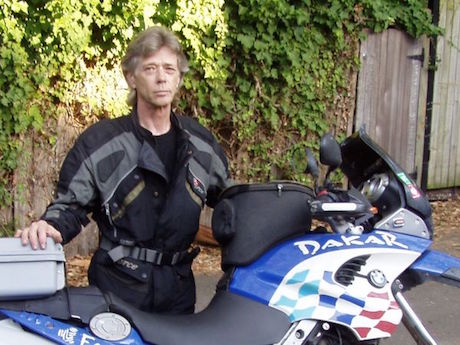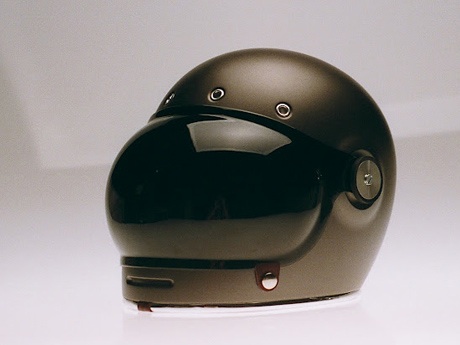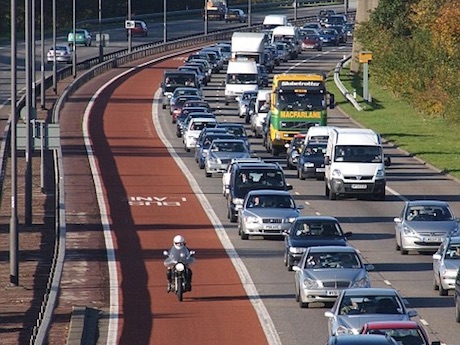Our current laws on use of a tinted visor on a motorcycle helmet are so absurd they don’t even distinguish between riders and pillions says rider rights campaigner Wayne Carruthers.
He points out the ridiculous error in his submission to the National Transport Commission (NTC) which is reviewing Australian Road Rules to gain some uniformity across states.
There are three areas of the road rules that affect riders, including harmonising lane filtering rules, motorcycle control (eg allowing riders to push a bike without wearing a helmet, standing up while riding and removing feet from the pegs to stretch) and helmet compliance.
The Motorcycle Council of Australia, Ride to Review and Maurice Blackburn Lawyers have also made submissions.
Wayne has campaigned on helmet compliance and other issues for many years. You can read his full submission at the end of this article.

Tinted visor rule ‘absurd’
“The helmet Road Rule 270 in all states and the Australian Road Rules has some stupid pieces of absurdity,” he says.
“An example is the failure to distinguish between the tinted visor requirements for a rider and a pillion. A pillion is required to use the same visor as a rider, this is utter absurdity.
“Where a pillion has a dark tinted visor, the rider can be fined for allowing the pillion to do so then the pillion is also fined.
“Since there is only one offence of “Not wearing an Approved Helmet” in NSW this means a fine of $311 to each totalling $622. In the ACT the total is $748, WA $1100 and Tasmania $1300. What a load of rubbish.”
We are not aware of any pillions being fined for this absurd tinted visor rule, however the way the rule is written it could happen.
“Imagine if the pillion was visually impaired! That would be fun to watch in any court proceedings,” Wayne says.

Wayne’s submission covers other absurd aspects of Road Rule 270 and calls for the rules to be simplified and for approval of wider standards for visors.
In its submission, the AMC has logically called for helmet visors or goggles with visible light transmission of less than 50% to be used only during daytime.
Wayne says a tinted visor manufactured to other standards should be allowed, pointing out that Bell has photo chromatic lenses that change tint with exposure to the sun.
Apart form changes to the tinted visor ruling, Wayne also supports the use of helmet attachments such as cameras and Bluetooth units, edge filtering, use of bus lanes and using the engine to “walk” a heavy motorcycle while not wearing a helmet.
Timeline for review
A spokeswoman for the NTC says the proposed amendments to the Australian Road Rules will be considered by transport ministers at the Transport and Infrastructure Council meeting in November 2017.
“If approved, the amendments will be implemented by States and Territories through their local laws,” she says.
“As of this afternoon, we have received 15 submissions (two of the submissions are already published on our website).
“We are currently processing the others and will publish these on our website next Wednesday, when you will be able to read through the issues raised.”
Wayne Carruther’s submission for proposed Australian Road Rules amendments
The proposed amendments are substantial and would clearly under COAG good governance agreements require a Regulatory Impact Statement (RIS) prior to any adoption into the Australian Road Rules unlike some earlier revisions which were mainly procedural amendments for which an exemption from a RIS was granted. It would appear this old exemption may have been abused.
Road Rule 151A – Motorcycle Lane Filtering
A nationally consistent road rule allowing for lane filtering by motorcycles should be introduced.
The proposed rule however is deficient in that it does not provide for edge filtering on roads which have restricted pedestrian access such as motorways or freeways. It is during peak hour traffic in urban areas where filtering is most needed to improve motorcycle safety, traffic flow and reduce emissions by allowing motorcyclists to move to the front of stationary traffic. In many instances the safest path forward for motorcyclists is via either the left or right edges of the roadway which quite often also have motorway or freeway entry lanes. Where a motorcyclist is edge filtering on these roads the rider only has one lane of traffic to be wary of.
Road Rule 154A – Bus only lanes
This proposed amendment should not proceed or should make provision for motorcycles to enter and use the lanes but not obstruct the lanes.
NSW is the only State I am aware of which has bus-only lanes. These lanes are predominantly short lengths of road on multi-lane major roads at traffic lights in urban areas. The lanes are marked in the same colour are normal bus lanes and can be very difficult to recognise as different to the normal bus lanes. In heavy traffic the small signs preceding the start of the bus only sections are often obscured by larger vehicles in the LHS lanes preparing to turn left at traffic lights. The NSW lanes may also have markings on the roadway but where a bus is in the lane waiting at traffic lights the markings are not visible. Motorists who are aware motorcycles are permitted to use bus lanes expect motorcyclists to use these lanes and lane filter.
Some NSW police who have a negative view of lane filtering have issued infringement notices to motorcyclists for momentary entry and exit from the NSW bus only lanes in situations where there has been no road safety issue.
Road Rule 270 – Wearing Motorcycle Helmets
Road Rule 270 should be amended to specify the approved motorcycle helmet standards. The explanatory statement in the amendment package consultation draft does not reflect the content of the proposed road rule which means the proposed rule does not meet the intent of the amendment.
“Rule 270 is placing motorbike riders at risk of being penalised for wearing an ‘approved motor bike helmet’ that complies with a prescribed standard, to a level that does not take into account helmet wear and tear or modifications that do not compromise the safety of the helmet.
To mitigate the risk of unfair enforcement outcomes, rule 270 will be changed so that the relevant helmet standards are specified and allowance is made for some wear and tear and modification as long as the helmet inherently complies with the relevant helmet standard.”
Rule 270 (1A)
There is no proposal to amend rule 270 (1A), this rule needs amendment to cover further circumstances.
In emergency situations such as an accident, puncture or a machine mechanical malfunction, a motorcycle may require removal from a roadway or a roadway verge. At the current time the State road rules do not permit the use of the engine to move the motorcycle unless a helmet is worn.
Large touring motorcycles are heavy and difficult to move to a safe location when they have suffered minor damage or a puncture. In some cases requiring multiple people to move the motorcycle. The road rules must allow for the use of the engine in first gear to move a motorcycle without the vision restrictions of a motorcycle helmet and allow for non-motorcyclists present at the scene to assist with moving the motorcycle to a safe location without the risk of capricious issuance of infringement notices by enforcement authorities.
There have been a number of serious injuries and more than one fatality of people on the verge of roadways in emergency situations. Enabling moving of a machine to a safe location is an important safety issue.
Rule 270 (3) (a)
This should state was “manufactured and labelled in compliance with” not “was made in compliance with”.
Rule 270 (3) (b)
This rule is completely meaningless. Firstly labelling requirements are specified within the standards so a separate clause is redundant. Secondly Standards Australia does not have a “label or similar mark” indicating compliance of a motorcycle helmet with AS1698 or AS/NZ1698. Standards Australia agreed to discontinue any Certification Trademarks around 1990. Thirdly the requirement for a “label or similar mark” by a body accredited or approved by the Joint Accreditation System of Australia and New Zealand JASANZ) is requiring a mark which has no stated meaning, even a company logo would suffice thus it only promotes commercial interests associated with the NSW Government. In effect a levy by NSW on all other States.
NSW implemented a requirement of JASANZ “stickers” for AS1698 helmets manufactured after 2011. The implementation of this requirement was done without consultation or adherence to the COAG Good Governance agreements not to mention the fact that it met the technical requirements for referral to ICAC.
JASANZ was caught unaware of the rule and was subjected to complaints by motorcyclists who believed JASANZ mandated the change. Motorcyclists overwhelmingly have rejected the requirement for any labelling beyond that specified in AS1698 and AS/NZS1698. Manufacturers should be able to use any internationally accredited conformance assessment body to provide documentation to importers.
Rule 270 (3) (c)
Similar to Rule 270 (3) (b) this sub rule is redundant, the UNECE 22.05 labelling requirement is specified within the standard so there is no need for a rule which repeats the content of the standard.
Pillion Passengers
The current rules in all States do not differentiate the requirements between a pillion and the rider of a motorcycle for visors. Requiring a pillion to wear a visor with restricted Visible Light Transmittance (VLT) mandated for a rider is absurd and discriminatory towards the disabled community. A visually impaired person has the right to be a pillion on a motorcycle as do members of the community who suffer from excessive light sensitivity. At the current time in all States these people and the rider are at risk of capricious fines from enforcement authorities with visors and this should not be allowed to continue.
Visors and Goggles
Road Rule 270 (3) should have an exclusion clause or an additional clause to separate visors and goggles from the helmet standards. A clause should be implemented providing for visor specifications in line with all of the major international standards, UNECE 22.05, EN1938, BS4110, VESC-8, AS1609.
Australia is a small market and it has been observed over many years helmets on sale have had visors specified to different standards fitted to the helmets. Now with both UNECE 22.05 and AS1698 helmets approved for use importers and retailers cannot be expected to hold stocks of the same visors labelled differently for the same helmet models but which are marked as compliant with each of the standards.
Accessories and Attachments
The use of accessories on helmets must be specifically allowed where accessories are attached by a frangible mount. Some current enforcement authorities have been attempting to interpret helmet standards to issue infringement notices which has generated a high degree of conflict with motorcyclists.
Offences
The current use of only one proscribed offence for motorcycle helmets in the State road rules is bringing public administration into disrepute. The offence is “not wearing any helmet” where a motorcyclist may be wearing a helmet or visor compliant to a different standard thus creating a legal fiction with a very high penalty which does not reflect the impairment of safety in many situations. This creates unnecessary situations of conflict between motorcyclists and enforcement authorities. The offences need to be separated as is the case in New Zealand and was previously the case in the ACT and NT. The offences should be:
- Failure to wear helmet to approved Standard 1 points
- Failure to present helmet for inspection 2 points
- Failure to wear any helmet 3 points
Damage and Modification
The proposed road rule refers to where a helmet is “damaged or modified” the dictionary should provide basic definitions of the terms as road rules such as the Northern Territory previously did.
Road Rule 271 – Riding on motor bikes
The proposed amendment to Road Rule 271 is not mentioned in the consultation draft document so there is no explanation of the proposed amendment.
Some current State road rules reflect the current ARR rule but still do not provide for all the circumstances which may be encountered by a motorcyclist or pillion.
Motorcycle Riders
A rider must be permitted to remove a foot from the foot peg when standing. There are both comfort and medical reasons to do so on a momentary basis where it is safe to do so.
Road Rule 297 – Driver to have proper control of a vehicle
There is no proposal for amendment of this rule in the amendment package and it needs amendment.
The stipulation in rule 4, sub rule (3) of a maximum distance of 500m in the exemption for farming activity is too restrictive. In the arid areas of many States the distance between farm gates is often greater than 500m and it does not provide for drovers legally moving cattle on the “long paddock”. These drovers often need to get animals to the head of a mob of cattle quickly for road safety reasons which is often best done with a motorcycle. A less restrictive exemption is needed.




